What is Women Talking about?

Women Talking is a film is based on real events that took place between 2005-2009 when more than 100 Mennonite women living in a secluded colony in Bolivia were drugged and raped by the local men. The attackers blamed the victims’ claims on “wild female imagination.” As an aggressive counter, the movie (which is based on a book that carries the same defiant tone) states in the opening seconds that what we’re about to see is “an act of female imagination.” It’s a cheeky way of positioning the movie’s framework, which provides the space and breadth for these Mennonite women to talk and determine they and their children’s future. The movie is calling out the unfortunately popular notion that women could imagine something so heinous, while also noting the irony that this is the first time in these Mennonite women’s lives they’ve been allowed to imagine a civilization where they will feel safe and empowered.
While we usually laud films for “showing” rather than “telling,” Women Talking is very pointedly a film about telling. These Mennonite women have never had the space to converse and emote and project. Their voices have constantly been buried by the men of the colony. So on this night while the men are away, these women share a frantically important conversation that comes to embody their indefinite struggle. This leads to frustration and disagreements, as they have one night and one night only to navigate decades of silenced aspirations, grievances, and resentments. Throughout this discourse, the women are challenged in several different ways—in their social ideologies, in their faith, in their motherly instincts, in their philosophies on life. What decision will satisfy all these various avenues? In the end, they choose to leave their colony and build their own world where women have a choice, where their children have a future.
Cast
- Rooney Mara – Ona
- Claire Foy – Salome
- Jessie Buckley – Mariche
- Judith Ivey – Agata
- Ben Whishaw – August
- Frances McDormand – “Scarface” Janz
- Sheila McCarthy – Greta
- Sarah Polley – Writer and director
The ending of Women Talking explained
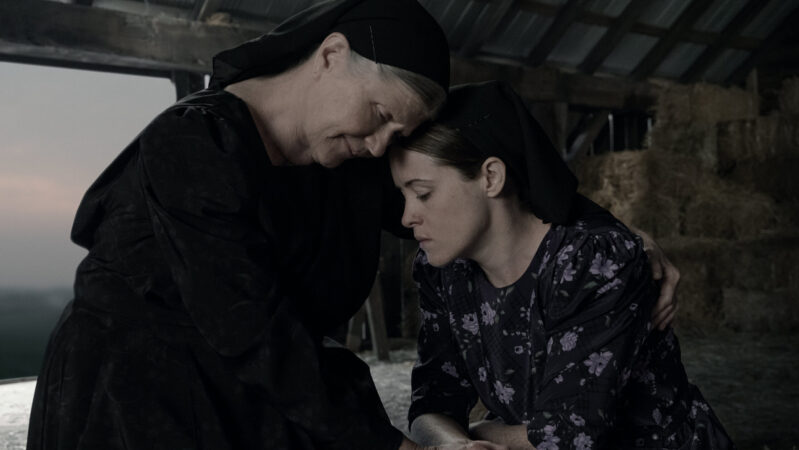
A recap of Women Talking‘s ending
After a long, arduous discussion, the women decide to leave their Mennonite colony before the men arrive home. They agree on three reasons for their departure: to ensure the safety of their children, to be unwavering in their faith, and to have the freedom to think freely.
August transcribes these principles as the women rush off to gather their belongings and inform the rest of the women of the colony. Before they leave, Ona asks August to keep their “pros and cons” documents on the walls of the barn for the men to see. As Ona walks away, August yells that he loves her.
As part of their discourse, the women agree to take any child under the age of 15, but not force any child over the age of 12. Salome, however, cannot convince her son Aaron to leave. So she breaks the rules by tranquilizing her own son and forcing him to come along.
August tries to give Salome the meeting minutes, but she tells him to keep the notes as artifacts of the women’s grueling conversation. August then tries to give her a gun, revealing he had planned to use it on himself—which prompts Salome to encourage August to never give up hope. She makes him promise that he will teach the boys of the colony to be good men.
As all the women line up to exit the colony, Scarface’s daughter and granddaughter rush over the join the group, defying Scarface’s wish to remain in the colony and do nothing about the situation. The women then take off to build their own civilization.
The meaning of Women Talking‘s ending
The ending of Women Talking is rather straightforward, but it’s important to note several thematic threads that are tied.
First of all, we must address Ona and August’s relationship. August says that he loves Ona, that he would be willing to take care of her and her unborn child. The baby will belong to the man who raped Ona, which creates an interesting parallel. August, a good man, would be a great father to this child. And Ona would be happy to have him. But August can help more than just Ona’s child: as a schoolteacher, he can teach goodness and kindness to all the boys of the colony.
This ties into the generational themes of the film. August and Ona’s love is strong, and they would be nurturing parents to their child—but they must each make a sacrifice for the advancement of humanity. If August leaves and his students grow up without a proper fatherly model, then they could turn into the kinds of monsters that forced themselves upon women like Ona. August must trust Ona to raise the child herself, and Ona must trust August to instill valuable, progressive morals in the boys of his class.
This dynamic plays into the conversation between Salome and August as well. August—who is so distraught by the actions of the colony’s men, who is so depressed that this entire situation has caused Ona to leave—wishes to take his own life. But Salome encourages August to remain alive, to be hopeful that he can make a difference in these boys’ lives. It may be tough, but you have to do what’s right—which is exactly why Salome sprays the very tranquilizer that was used on her on her own child.
Once again: sacrifice. August wants to be with Ona. But by giving up his love, he will be able to empower these boys to grow up in his image and find their own true loves. And Salome understands the cruel irony of using the tranquilizer on her own son. But the pain of the moment will be eclipsed by Aaron’s ability to grow up in a honest, nurturing environment.
Then there’s the meeting minutes August transcribed. August tried to give the notes to Salome, to which she responds, “No—those minutes are for you.” In a way, Salome is speaking to the men of the audience. While the women of the film certainly have their disagreements about how to handle the situation, they all inherently understand the situation in ways a man never could. Which makes their discourse so necessary: it’s on display for the men of the world—August, the men of the colony, the men watching the movie—to hear and contemplate. It’s a call for empathy—for the more privileged gender to listen, to understand, to never question.
The final component of understanding the end of Women Talking involves Scarface’s daughter and granddaughter, who defy Scarface’s wishes and join the women fleeing the colony. This ties in the themes of faith and forgiveness. Scarface and her family, who have voted to remain in the colony and do nothing, initially leave the meeting because they believe the inability to forgive the colony’s men would result in their banishment from heaven. Their faith is truly steadfast in the sense that there’s no room for nuance: you must always forgive others, no matter how heinous the sin.
But the movie begs the question: is that truly the case? The conversation in the barn reveals several different layers as a response. Salome wishes to never forgive and instead inflict violent; Ona believes that with time and separation and contemplation, she can feel empathy for the men and learn to forgive them; while others that remaining behind and agreeing to forgive could set a dangerous precedent for the future.
To tie this all back to the themes of faith and forgiveness, the group wonders: how could an omnipotent God allow for such terrible things to happen? This very question arises the complexity of God’s ways, and how difficult it is to accept a set of religious principles that guide your life. The men of the colony certainly weren’t Christlike—so why should the women take the high road? Isn’t it fair to fight fire with fire? Shouldn’t these men forever live without the women’s forgiveness? Is it truly moral to forgive even when you don’t mean it?
The truth is: there’s no concrete answer to any of these questions. These are dilemmas that will forever plague humanity as we try to live our lives to the highest possible standard.
But with their departure, Scarface’s daughter and granddaughter make one thing clear: they aren’t willing to accept “what is.” Just because Scarface claims forgiveness is the only way into heaven doesn’t mean that is so. People are free to consider every possible viewpoint, to use their own intuition and consider their own emotions in finding the proper path. So in the end, they decide to move forward with society, to refuse to remain stagnant like Scarface. Time can’t move forward if you’re constantly holding it back.
The themes and meaning of Women Talking
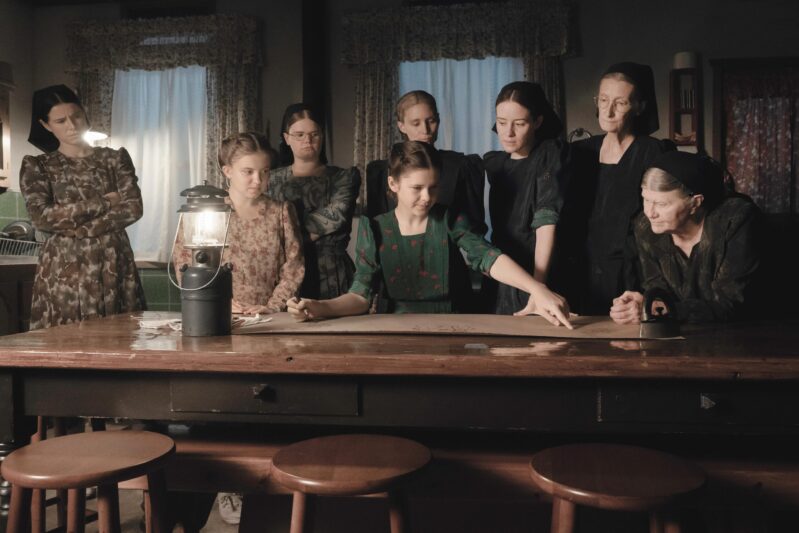
Faith and forgiveness
The women of Women Talking exist in a colony of Mennonites, who are members of the Anabaptist Christian church community. According to the Dordrecht Confession of Faith, the Mennonites believe in “the baptism of believers only, the washing of the feet as a symbol of servanthood, church discipline, the shunning of the excommunicated, the non-swearing of oaths, marriage within the same church.” Essentially, the Mennonites had very strict rules regarding faith and achieving eternal life in heaven.
The movie positions a scenario that forces the women to question the nuances of that doctrine, which requires them to forgive even the most heinous of crimes in order to gain entry into heaven. The women are forced to ask themselves a number of questions in regards to their faith: How can you forgive something so terrible and hurtful? Would violence against these men be forgiven by God? Can you learn to forgive not through requirement, but through empathy and understanding? Or are you justified in your refusal to forgive?
The movie revolves around these questions as the women decide their futures. Whatever they choose could have consequences in the afterlife, which puts them in an incredibly precarious position. Yet, it’s a conversation that must be had, a decision that must be made.
Fighting for the future
There’s a striking scene in Women Talking when the women pause their conversation in order to tend to a young boy in pain. What follows is an elegantly orchestrated montage of flashbacks, of reflection, of prayer that gives weight to the true underlying questions of the film: How do we prevent this from happening to our children? How do we protect our girls and give them a voice? And how do we educate our young boys to become compassionate men who listen to women and view them as equals?
This fight for the future explains the explosive rhetoric that permeates the film. Of course these women are reacting to trauma inflicted by Mennonite men—but more than that, these women are fearful that the same trauma will be passed onto their children. You could stay and fight…but how has history shown that to be a viable option? What power do these women—does any woman in society—truly have if peopel aren’t listening? How could these problems persist for so long if there were feasible solutions?
The only way to prevent such cruelty and inequality, they decide, is to flee and build your own civilization. When you are silenced, you must manifest your own doctrine, your own set of principles that will cultivate an open world where your voice will be heard. When you’re empowered, then your children will be empowered, and their children will be empowered—and so on. The generational effect of taking charge and demanding change is astounding. You can’t be too scared to fight, as the lives of so many for generations to come are on the line.
Why is the movie called Women Talking?
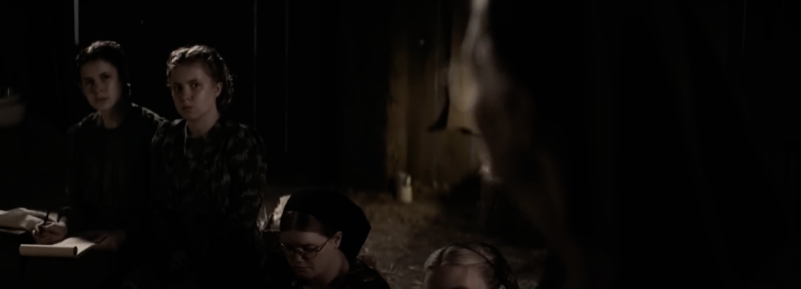
The reasoning behind the title of Women Talking is very obvious, but it’s also very profound for this particular situation. The movie—which is based on a terrible true story—features a colony of Mennonite women who discover that the local men have been tranquilizing and raping them for years. While the men are away to take care of bail for the imprisoned accused, the women are left to vote between three options: they can do nothing, they can stay and fight, or they can leave the colony. After the latter two options wind up in a tie, selected women sit down to talk, to decide which path is best for the rest of the women in the colony.
This is an interesting approach for a film—a medium for which we usually reward “showing” over “telling.” But Women Talking posits the importance of discourse in the art of film. Movies can certainly defamiliarize any situation; they can create metaphors and allegories that reflect the joys and cruelties of life back onto the audience. But when a topic is so important, so consequential, so heinous for that reflection…perhaps symbolism and analogies aren’t the best avenues. Perhaps its best to confront these topics head-on, to thrust the audience into an incredibly monstrous yet incredibly relevant discussion. This blurs the relation between fiction and reality, as this “movie” feels strikingly familiar and authentic.
The film candidly plays with this idea of fiction vs. reality in the opening seconds. Women Talking opens with a quote that claims the movie is “an act of female imagination.” This is in reference to the accused men who, in real life, claimed the Mennonite women’s allegations were nothing more than “wild female imagination.” And that should be no surprise. When women make these kinds of accusations in real life, they are constantly called liars; people like to spin their horror stories as nothing more than fiction. The movie’s opening quote is a nod to this notion.
But that opening quote also pairs so perfectly with the film’s title. At one point during Women Talking, Ona turns to August and asks him, “How would you feel if in your entire life it never mattered what you thought?” This brings a striking sense of reality to the film: women who have been subjugated and abused and disenfranchised by society, who have been called liars and storytellers, who have never gained the same rights as men—they live in a world where it doesn’t matter what they think.
The movie then provides that space. Not only will these women think, but they will talk. They won’t talk to men, but they will talk to other women who inherently understand the plight. They will navigate the troubled waters of gender politics and abuse and misogyny that prevent them from moving forward and building a more inclusive society. They will finally get to imagine a better life, a better world for themselves and their children. They need to finally have this conversation—this conversation that has been denied for so long. They need a multitude of amplified female perspectives that allow for a nuanced, aggregate consensus on how to finally bring balance to humanity.
Important motifs in Women Talking
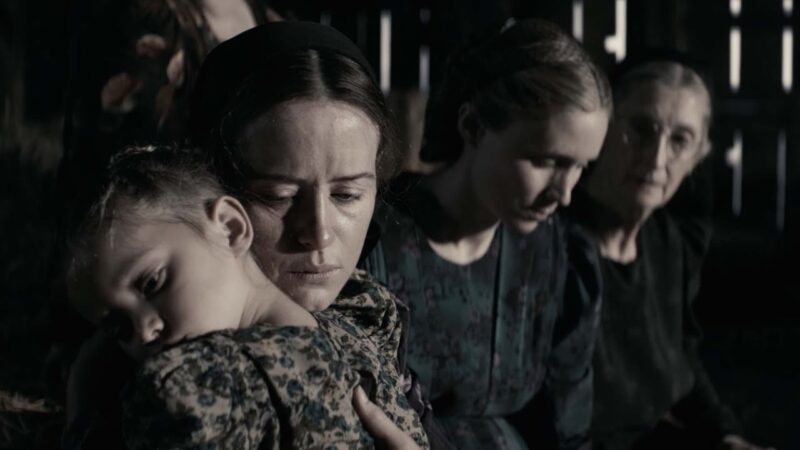
Animals
There are some interesting parallels drawn between animals and people throughout Women Talking. Greta’s quote sets the table when the women are discussing how they should respond to the men who committed the terrible crime: “We have been preyed upon like animals. Maybe we should respond like animals.” This paints animals as reactionary creatures, as opposed to human beings who are emotionally intelligent creatures. Basically, Greta posits: when an animal is threatened, it reacts with savagery—so why shouldn’t these women behave the same? Well, obviously, there’s another side to that coin.
This is a major component of the women’s debate: do you stand by idly and forgive, or do you fight back and condemn? For several of the women, like Salome and Mariche, their instinct is the latter option. But people like Rooney and Agata push for peace and empathy. These men should surely be punished…but should it come at the hands of these women? Does violence solve the problem if it damages your soul? Should we be reduced to animal instincts?
The energy surrounding these women’s conversation deviates between light and dark—emotional empathy and animalistic revenge. So throughout Women Talking, when the camera focuses on animals, from Greta’s horses to dogs running alongside children to birds fluttering in the bar, there’s a note of irony. Animals are simple creatures that react in animal-like ways, like how Greta’s horses run from dogs in fear. But humans are different. They’re able to assess situations and come to logical, emotionally intelligent decisions. Women Talking shows the power of conversation by juxtaposing these women (as well as the men) against the animals.
Artifacts
Women Talking is essentially a film about a group of women who are abandoning one world to start a new one. They’re sick of the way they’re treated in their Mennonite colony and would like to build a new colony in their ideological image: a world where women are treated kindly and fairly; a world where boys and girls are raised to respect one another. But still, it’s important that reminders of these women’s struggle remain in the old world.
You can think of the notes, pros and cons lists, and drawings as artifacts of their struggle. When August tries to hand the meeting minutes to Salome, she tells him to keep them. “No—those minutes are for you,” Salome says to August. But “you” in this case refers to the men of the colony as well as August. It’s important for them to hear the women’s thoughts, for there to be a record of the conversation that took place. These sorts of artifacts help the old world make sense of its mistakes and grow. This thread highlights the importance of studying history and understanding our collective past.
Questions & answers about Women Talking
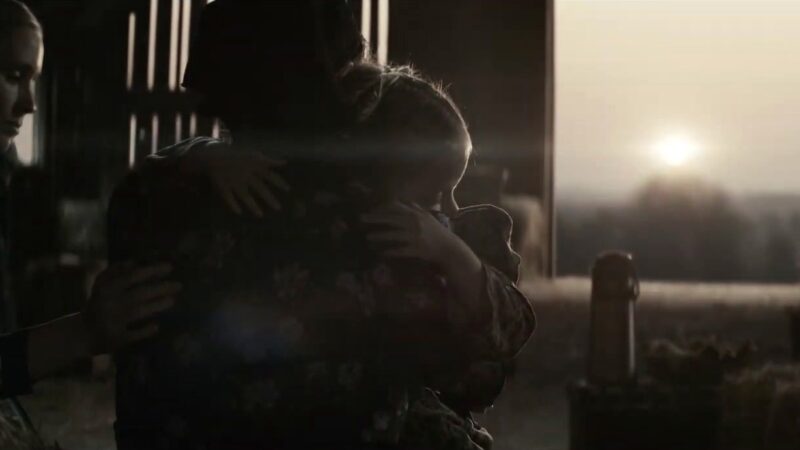
Is Women Talking based on a true story?
Yes. Between 2005 and 2009, more than 100 women in a Manitoba Colony were raped by a group of local men who had sedated the women with a gas used to sedate animals during medical operations. The victims range from elderly women to infants—a truly awful situation. After the women reported the attacks, the men dismissed the accusations as “wild female imagination,” and even went as far as to blame the attacks on ghosts and demons.
The film is based on a book by Miriam Toews, who made these crimes the center of her story.
What does Salome spray on her son?
Salome sprays the animal tranquilizer on her son to force him to leave.
When the Mennonite women agree to leave the colony, they also agree to not forcibly remove any children over the age of 12. But Salome’s son doesn’t want to leave. If you’ll remember, when Salome found out her son was hiding because he didn’t want to leave, she ran off to find him. During a montage towards the end of the movie where women are gathering their belongings and family members, we see Salome’s son coldly staring out the window. The implication is that he is refusing to leave. So Salome takes matters into her own hands and sedates her son.
The irony here is that the same tranquilizer was used on the Mennonite women, was the entire reason these women were choosing to leave the colony. Thus, Salome’s use of the tranquilizer becomes a penetrating commentary on power. The men used the tranquilizer for despicable reasons. But Salome’s reason was pure: as she didn’t want her son growing up around these monsters. The film posits that in this grand societal fight for equality and accountability and justice, you may have to get your hands dirty. If you don’t, the powerful will continue to walk all over you.
Where were the men when they left?
This question comes to us from Kim in the comments section. The reason the men weren’t there to restrain the women when they left the commune is because they went to town to bail the other men from jail. Only one man, Mariche’s husband Klaas, returns to town to collect more bail money. But he couldn’t stop them either because he was so drunk from the night before.
Beyond that, it’s probably worth questioning how these women thought they could get away with all the children. Wouldn’t the men find them and bring the children back? But the movie doesn’t concern itself with anything after the women’s conversation.
Why didn’t the men object to other men using their women and daughters?
Unfortunately, I don’t believe the movie provides a concrete answer to this question. My guess is that such a patriarchal society was so ridden with machismo and ego that it bred an expectation this sort of behavior was acceptable. Or it was something the men didn’t and never discussed but accepted. Either way, it seems the men’s acceptance of something so despicable is part of the social commentary.
It’s also important to remember that this actually happened in real life—-and actually may have been far more gruesome that it was portrayed in the film. So while it might seem outlandish in the film, it is an accurate depiction of what actually occurred in the settlement of Manitoba Colony.
Now it’s your turn
Have more unanswered questions about Women Talking? Are there themes or motifs we missed? Is there more to explain about the ending? Please post your questions and thoughts in the comments section! We’ll do our best to address every one of them. If we like what you have to say, you could become part of our movie guide!

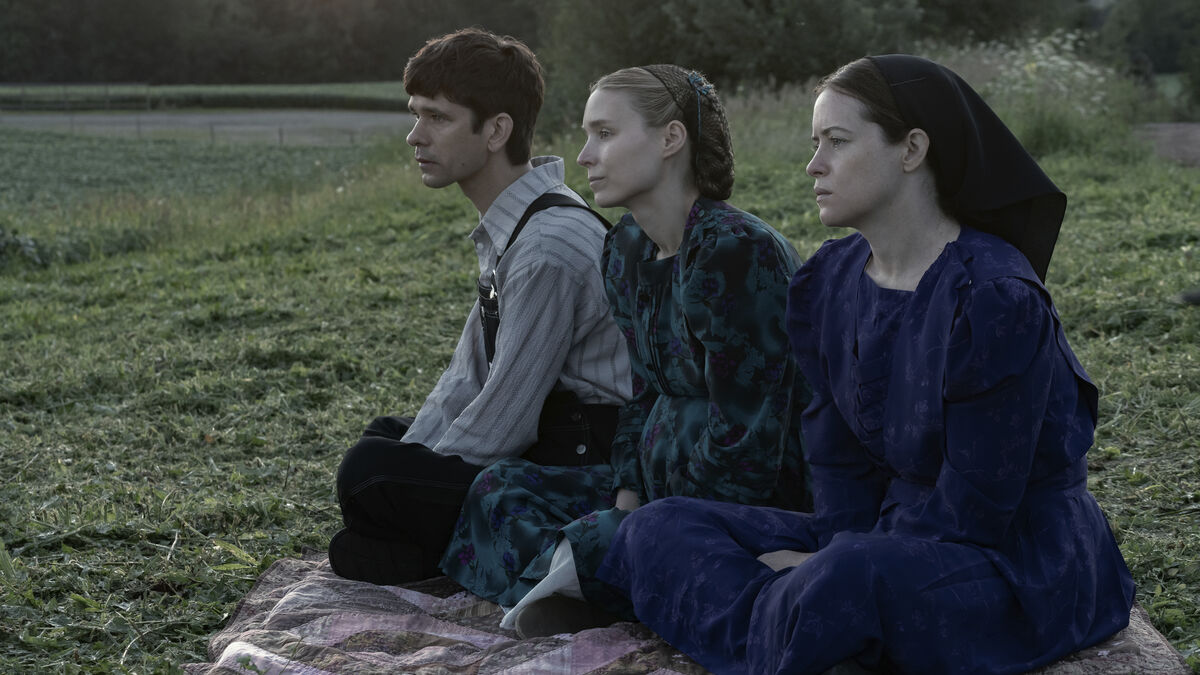
Was it 300 women in Bolivia in 2005 or 100 women in Manitoba 2005-2009? This piece says both.
Fixed! Thank you for spotting that.